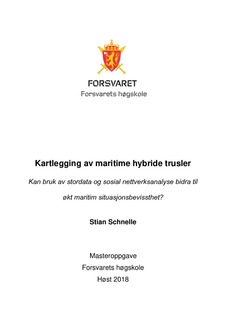| dc.description.abstract | Denne oppgaven handler om hvordan stordata og sosial nettverksanalyse (SNA) for kartlegging av maritime hybride trusler kan øke situasjonsbevisstheten i det maritime domenet. Hybrid krigføring kjennetegnes ved en koordinert bruk av statens maktinstrumenter (militære, politiske, økonomiske, sivile og informasjonsmessige)1 der irregulære virkemidler i stor grad har tatt over rollen til regulære militære maktmidler. Denne helhetlige tilnærmingen til konflikt har blitt aktualisert med bakgrunn i Russlands handlinger på Krim. Hensikten til en hybrid aktør er å skape en situasjon preget av tvetydighet og tvil, slik at det oppstår en uklar gråsone mellom krig og fred.
I Sør-Kina-havet har spenningen økt mellom Kina og USA. Kinas oppbygging av kunstige øyer, og etableringen av en maritim «milits» bestående av sivile fartøyer anses å være svært utfordrende. Russisk maritim doktrine anerkjenner også sivile fartøyer som viktige bidragsytere til russisk projeksjon av sjømakt. Ser vi dette i en sammenheng, fremmer dette et behov for større fokus på kartlegging av aktører og mulige nettverk i det maritime domenet. Maritim situasjonsbevissthet i dag fokuserer på bruk av tradisjonelle disipliner som etterretning, overvåkning og rekognosering. Det lite tilgjengelig forskning på maritime nettverksstrukturer. Denne oppgaven besvares med kombinert metode der en omfattende kvalitativ litteraturstudie legges til grunn for og kombineres med en kvantitativ stordata- og nettverksanalyse av historiske Automatic Identification System data (AIS).
SNA kartlegger mønster og relasjoner mellom sosiale aktører og koblingen mellom aktørene danner et nettverk som videre analyseres. Hensikten med studiens analysedel er å gi et «proof of concept» for at bruk av AIS-stordata og SNA til kartlegging av maritime hybride trusler kan bidra til økt situasjonsbevissthet. Fokuset for oppgaven er kommersielle russiske fartøyer i norske interesseområder. Gjennom bruk av stordata og SNA har algoritmisk filtrering av store mengder data kombinert med bruk av åpne kilder og databaser bygget maritime nettverksstrukturer. Studiens hovedkonklusjon er at stordata og sosial nettverksanalyse vil kunne bidra til økt maritim situasjonsbevissthet, inkludert kartlegging av maritime hybride trusler, forutsatt at det benyttes som et supplement til eksisterende prosesser og systemer. | nb_NO |
| dc.description.abstract | This thesis analyzes use of big data and social network analysis as a contribution to increase Maritime Domain Awareness (MDA) by mapping maritime hybrid threats. Hybrid Warfare takes a coordinated, systematic and comprehensive approach using military, political, economic, civil and informational instruments of power (MPECI) to achieve the state`s ends. Hybrid threats are designed to deliberately blur and blend to create a high degree of uncertainty and unpredictability, caused by increased importance of the non-military measures and irregular tactics which in many ways has surpassed the importance of conventional military measures. Having attracted new attention in the aftermath of the Ukraine crisis, such grey-zone activities between war and peace can prove challenging to detect.
The situation in the South-China Sea, where China is conducting terra-forming operations to build artificial islands combined with the establishment of a maritime militia of civilian merchant vessels and fishing vessels, is challenging the USA. This, in conjunction with the Russian Maritime Doctrine which regognizes civilian vessels as contributors to russian projection of sea power, it highlights a need to focus on identification and mapping of actors and networks in the maritime domain. Very little available social network research has been conducted on mapping of possible maritme hybrid threats in the maritime domain. This thesis uses a mixed methods approach where the first part creates a qualitative foundation for the combination of the quantitative analysis in the second part. The thesis considers how to infer a social network based on location information captured from historical Automatic Identification System (AIS) data.
SNA provides the capability to detect and analyze patterns of social ties between actors, and how these create structures and networks which again can be investigated. The analysis in this thesis will be conducted as a «proof of concept», combining big data and SNA for the mapping of hybrid threats to increase MDA. The main scope for the thesis has been mapping of commercial russian networks. By creating customized data structures, and by implementing algorithms filtrering and data combined with open source and database investigation the social networks were designed. The thesis has identified behavioural patterns and maritime networks by identifying ships, their owners, and geo-locations. The main finding of the thesis is that a combination of big data and social network analysis can provide added value to the MDA process, including identification of possible hybrid threats. | nb_NO |
